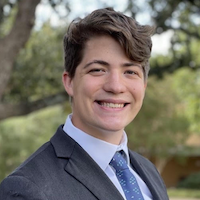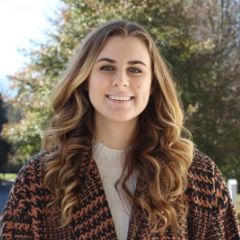Session 3: 2:30 PM - 4:00 PM
Panel A: Ecological Resilience: Reconceptualizing Sustainable Solutions Amidst a Climate Crisis
Moderator: Ellis Adams

For Sustainable Development We Need to Look to the Past
Buhle Sibanyoni, University of Pretoria
Abstract
Human development throughout history has been done without acknowledging the possible consequence of the methods used, however, we no longer have this luxury; with the growing climate crisis and the continuous need to develop states the question comes, how can we develop the world whilst limiting the environmental effects? This can be done by looking into our past and taking “traditional” methods and applying them to our world today. Africa was a continent without borders, allowing agriculture to develop and Africans to take advantage of the agriculture; although it is not possible to currently erase these borders similar strategies can be used by farming specific crops in specific states where they would thrive. Africa has large unemployment and low development rate, this would create jobs, allowing people to provide for their families and it also produces foods that can be traded within the African continent.
Other practices can be adopted from Native Americans; the lifestyle of Native Americans is under threat from climate change, with the increase in forest fires and the decrease in animals such as fish and deer resulting in Natives losing their food supply. Methods such as hunting and gathering from the environment can be utilised; with the extreme seasonal changes experienced in Alaska and Canada methods of hunting, preserving, storing, and rationally eating, and harvesting vegetables and fruits during the summer, spring season’s then storing and preserving them allows them to have food throughout the winter (6 months), similar methods have been used in Africa.

Crime, Climate, and Commerce: Deforestation and Modern Slavery in Bangladesh
James Sanford, University of Dallas
Abstract
In the southwestern coast of Bangladesh lies the Sundarbans, the largest contiguous mangrove forest in the world and the largest carbon sink in Asia (Bales 2021, 4). In these mangrove forests teems a dense ecosystem fostering large shrimp and fish populations. While fish catches are primarily consumed domestically, the high value shrimping yields are exported to the US and the EU. Tragically, the deforestation of the mangroves by regional shrimp firms to construct shrimp aquaculture ponds result in the exploitation of people living in the Sundarbans. Often mafia-run, these firms have the infrastructure in place to capture the economic benefits of mangrove deforestation and financially coerce many vulnerable villagers to labor as modern slaves. The ponds reduce local fishing yields and land value, which leaves many locals reliant upon the land vulnerable to exploitation by the mafia. Approximately 8,500 hectares of mangrove forests have been deforested in the Sundarbans for shrimp aquaculture ponds, with land value depreciating by $10,000 per hectare (Ahmed 2017, 69). Through analysis of the current literature which utilizes remote sensing data to track the illegal construction of shrimp aquaculture ponds, as well as literature exploring the ties between environmental degradation and modern slavery, my research addresses how the mafia’s deforestation of the mangrove forests in the Sundarbans creates a cycle of environmental destruction leading to exploitation through modern slavery, which will cause greater deforestation. It is paramount that we understand this cycle in order to enact economic solutions to eliminate slavery in the Sundarbans.

Examining the Feasibility of Zero-Liquid Discharge at Nesjavellir Power Plant
Grace Hegland, Swarthmore College
Abstract
Several studies suggest that the effluent management practices of the Nesjavellir power plant are contributing to chemical and thermal pollution in Lake Thingvallavatn, which is a rift lake of high conservation value. However, research to fully understand these impacts and to determine ways to mitigate the pollution has yet to be conducted. I used a literature review to assess the chemical and thermal pollution in Lake Thingvallavatn. Then, I evaluated the feasibility of implementing Zero Liquid Discharge (ZLD) to mitigate pollution. ZLD uses desalination methods to produce freshwater and completely remove liquid waste. In the power sector, ZLD treats power plant effluent to eliminate wastewater being sent to receiving bodies. I used another literature review and worked with a professor with a background in desalination to design a ZLD treatment train for the Nesjavellir power plant. I then conducted a techno-economic assessment of the feasibility of implementing this proposed train and consulted with professors and PhD candidates at various universities in Iceland to determine the barriers to ZLD implementation. I determined that while a ZLD treatment train is feasible for the Nesjavellir power plant, its addition is unlikely to occur unless accompanied by more research on the pollution at Lake Thingvallavatn and tighter wastewater disposal regulations.

Sequester My Carbon
Lucille Ketterer, Bucknell University
Abstract
The planet has warned us: change is coming. Now, its people are crying out too. The past decades have seen a tripling in climate-related disasters, not to mention, 20 million citizens are removed from their homes every year due to climate change. Some call it “billion-dollar weather.” I call it man’s last chance to change.
It goes without saying that greenhouse gases and criteria air pollutants are the biggest contributors to climate change. Of those, carbon dioxide is the worst. There continues to be discussion in the media over lowering one’s carbon footprint, but entities are often caught up in the question of “How?” That is where my research comes in, bridging the gap between knowing and doing.
Iceland, as one of the greenest countries in the world, has mastered the various forms of carbon sequestration. They use direct air capture, injection into basalt, carbon forestry, and regenerative agriculture as means to sequester carbon from the atmosphere, amongst other practices.
Through a series of interviews, site visits, and a literature review, my research explains to towns, companies, and individuals how to best sequester their carbon. Its results are based on one’s U.S. geographic location, funding, and available resources. For an interactive format, refer to the MATLAB code; for generalized results, go to my website: https://ljk010.wixsite.com/sequester-my-carbon.
The following research has been conducted under the School for International Training. The specific program is Iceland: Climate Change and the Arctic.





